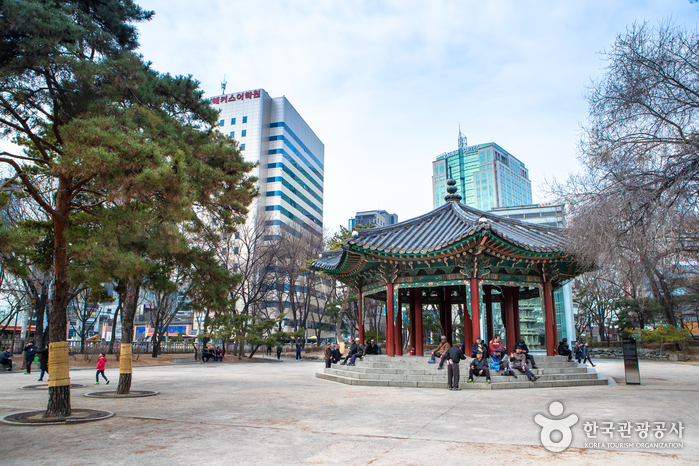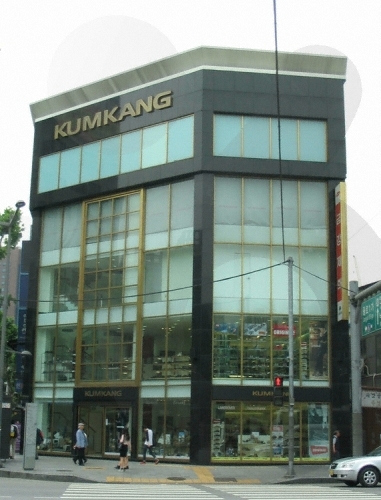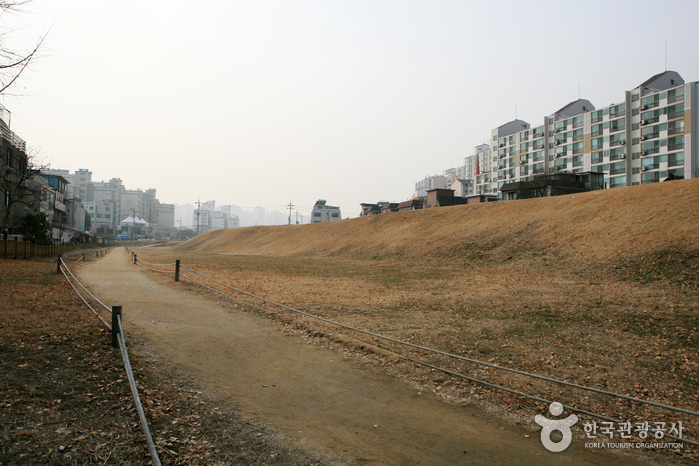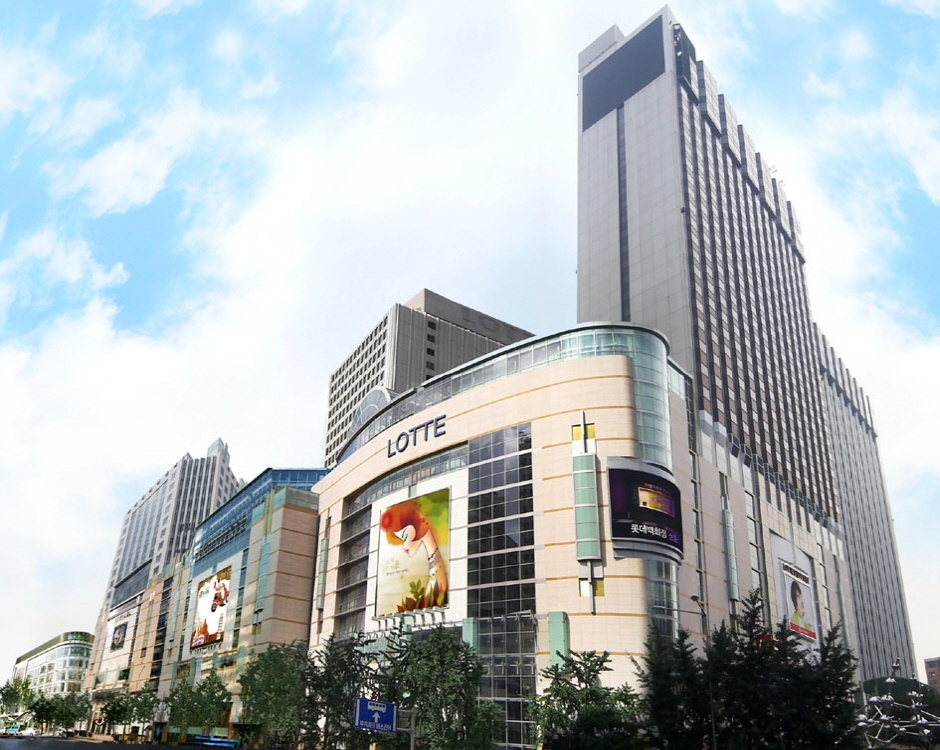Tapgol Park (탑골공원)
7.2Km 2024-03-04
99, Jong-ro, Jongno-gu, Seoul
+82-2-731-0534
Tapgol Park is the first modern park in Seoul. Having been the site of the Buddhist temple of Wongaksa Temple since 1467, the land was turned into a park in 1897. The park has a significant presence in Korean history, being the place where the March 1 Independence Movement began in 1919. One can find historical sites that hearken back to the struggle, such as the Palgakjeong Pavilion, the center of the movement; cultural heritage sites such as the Ten-story Stone Pagoda of Wongaksa Temple Site and the Stele for the Construction of Daewongaksa Temple at Wongaksa Temple Site; and monuments such as the independence movement relief plate, murals, the statue of Son Byeong-hee, and the statue of Han Yong-un.
Kumkang - Jongno Branch (금강제화 (종로지점))
7.2Km 2021-07-19
89, Jong-ro, Jongno-gu, Seoul
+82-2-733-2744
Kumkang Shoes is Korea's leading fashion retailer specializing in formal, casual and athletic footwear, as well as trendy clothing and accessories. Located in central Seoul, Kumkang Jongno is easily accessible from major shopping areas such as Insa-dong and Dongdaemun Market. Moreover, this Kumkang branch has a tailor shop that provides tailoring and repair services.
Uniqlo - Sadang Branch [Tax Refund Shop] (유니클로 사당)
7.2Km 2024-04-18
B1 of Pastel City Sadang, 11, Bangbaecheon-ro, Seocho-gu, Seoul
-
Pungnap-dong Toseong Fortress (서울 풍납동 토성)
7.2Km 2025-01-10
Pungnap-dong, Songpa-gu, Seoul
+82-2-2147-2800
Onjo, the progenitor of Kingdom Baekje, first settled in Wiryeseong Hanam. But exact location is still unknown. One thing for sure, however, is that Pungnaptoseong Fortress, Mongchontoseong Fortress, Bangidong Ancient Tombs of Baekje, Seokchondong Stone Mound Tomb of Early Baekje are the remains of Baekje. Pungnaptoseong Fortress faces Hangang River to its west and connects to Mongchontoseong Fortress to the south. To the northwest faces Achasanseong Fortress over Hangang River and far to the southeast is Namhansanseong Fortress.
Pungnaptoseong Fortress, located at the south end of Cheonhodaegyo Bridge over Hangang River, is one of the remains of Early Baekje. Originally, the fortress was 4km in circumference, but due to massive overflowing of Hangang River during flood season in 1925, most of the fortress was lost and only 2.7km of it remains. To the east of the fortress are 4 vestiges of the fortress gates. The remains from the prehistoric era through the Samguk (Three States) era have been unearthed, indicating that this place was a residential area well before the Baekje Era. Through vigorous excavation, some people suggest that there used to be a palace located here during the Baekje Era.
Lotte Duty Free Shop - Main Branch (롯데면세점 (본점))
7.2Km 2025-01-07
30 Eulji-ro, Jung-gu, Seoul
+82-759-6660
Lotte Duty Free Shop is located on 9-12F of Lotte Department Store, in the center of Seoul. Lotte Duty Free Shop is a one-stop shopping complex providing shoppers a wide range of products. Lotte Duty Free Shop in Myeong-dong offers luxury brands such as HERMES, LOUIS VUITTON, CHANEL, CARTIER, and others. Also, visitors can enjoy a unique experience of purchasing beauty products using innovative digital technology at the Smart Store on floor 1.
[Directions]
Get off Subway Line 2, Euljiro 1(il)-ga Station, Exits 7 & 8 and walk straight for 50 meters and turn right.
Pierre Gagnaire à Seoul (피에르 가니에르)
7.2Km 2019-12-24
30, Eulji-ro, Jung-gu, Seoul
+82-2-317-7181
Internationally renowned as a Michelin three-star chef, Pierre Gagnaire opened his Seoul restaurant, Pierre Gagnaire à Seoul, on October 1, 2008. This is his fourth restaurant following those restaurants in Paris, Tokyo, and Hong Kong. In fact, he was once ranked first among the 100 top chefs in the world. It offers French cuisine featuring innovative and diverse preparation methods with an added artistic touch.
Momoyama (모모야마)
7.2Km 2019-12-17
30, Eulji-ro, Jung-gu, Seoul
+82-2-317-7031
Momoyama is a Japanese restaurant that serves high quality sushi and kaiseki (tasting menu of small, intricate dishes). In addition, the restaurant features a collection of 80 different types of sake along with a sake somelier. The restaurant is also equipped with several private rooms of varying sizes.
SAERAN OPTICAL[Korea Quality]/세란안경[한국관광 품질인증]
7.2Km 2024-06-25
30 , Eulji-ro, Jung-gu, Seoul
+82-10-8746-2715
Seran Optical Center is a specialty eyewear store on the 1st basement floor of the Lotte Hotel in Jung-gu, Seoul, and opened in 1979 along with the Lotte Department Store and Hotel in Myeong-dong. Drawing on long-standing expertise, Seran optometrists offer a 1:1 customer-centered service, providing high-quality glasses and precision processing to suit customers’ lifestyle. There is also post-tax exemption for foreigners, and thorough post-sales support. Featured brands include LINDBERG, Cartier, CHROME HEARTS, and Berlin.
Prada - Lotte Main Branch [Tax Refund Shop] (프라다 롯데 본점)
7.2Km 2024-04-19
30, Eulji-ro, Jung-gu, Seoul
-
![Kangol [Tax Refund Shop] (캉골)](http://tong.visitkorea.or.kr/cms/resource/75/3312975_image2_1.jpg)


![Uniqlo - Sadang Branch [Tax Refund Shop] (유니클로 사당)](http://tong.visitkorea.or.kr/cms/resource/08/2889108_image2_1.jpg)



![Prada - Lotte Main Branch [Tax Refund Shop] (프라다 롯데 본점)](http://tong.visitkorea.or.kr/cms/resource/46/2889746_image2_1.jpg)
 English
English
 한국어
한국어 日本語
日本語 中文(简体)
中文(简体) Deutsch
Deutsch Français
Français Español
Español Русский
Русский